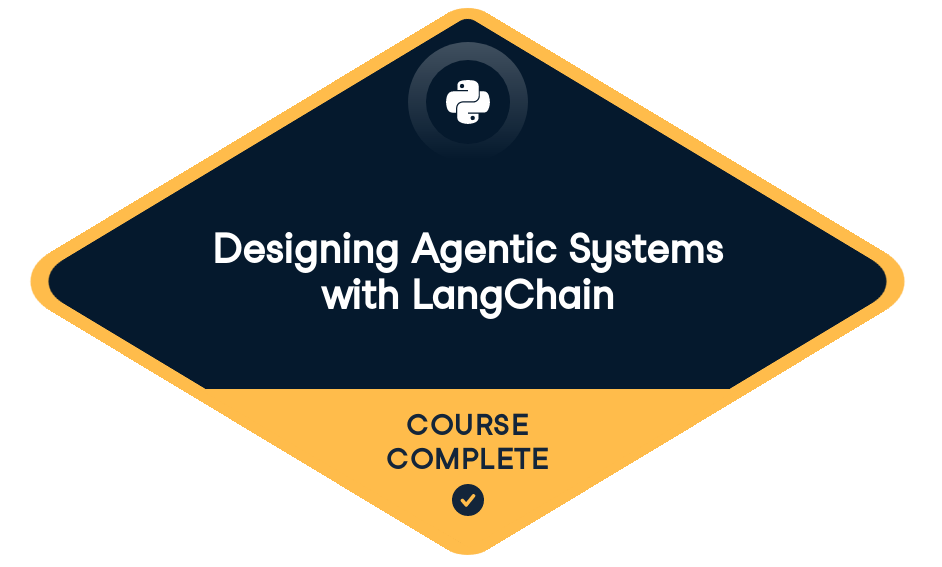
Loved by learners at thousands of companies
Course Description
Agentic workflows that integrate LLMs and tools to perform nuanced tasks are at the forefront of the AI transformation. In this course, you'll learn the key principles behind LangChain agents, including configuring prompts, integrating tools, and managing complex workflows. By the end of this course, you'll be able to build intelligent systems that automate complex tasks, enhance productivity, and provide dynamic solutions tailored to specific business needs.
Master the Essentials of LangChain Agents
You'll learn how to integrate prompts, language models, and tools into workflows using the Reasoning and Action (ReAct) framework. Following that, you'll be able to set up agentic workflows, configure tools, and understand the core principles of LangChain agents while visualizing these workflows with LangGraph. You'll build custom agents, set up tools for accessing external data sources like the Wikipedia API, and manage agent states. You'll be guided through defining nodes and edges, creating conditional pathways, and assembling complex workflows that adapt to varying conditions.Build Dynamic Chat Agents
Finally, you'll learn to monitor messages, define nodes for flexible function calling, and configure your chatbot for multiple-tool handling. By the end of this course, you'll be able to build intelligent systems that automate complex tasks, enhance productivity, and provide dynamic solutions tailored to specific business needs.Training 2 or more people?
Get your team access to the full DataCamp platform, including all the features.- 1
The Essentials of LangChain agents
FreeBuild intelligent agentic systems! Discover the key components of LangChain agents, including how prompts, LLMs, and tools work together for reasoning and action. You'll set up an agent with OpenAI's API, define custom tools, and tackle real-world tasks like math calculations. Plus, explore how LangChain organizes data using graphs, nodes, and edges.
Agents in LangChain50 xpCreating a ReAct agent100 xpComponents of LangChain agents50 xpBuilding custom tools50 xpCreate a tool for math calculations100 xpIntegrating custom tools and queries100 xpConversation with a ReAct agent50 xpConversation setup100 xpAsk questions about conversation history100 xp - 2
Building Chatbots with LangGraph
Build dynamic, tool-augmented chatbots with LangChain and LangGraph! You’ll explore how to create a chatbot that adapts based on user input by defining states and integrating external APIs for real-time information retrieval. You'll connect these components into a responsive graph structure, enabling smooth transitions between conversation and tool-assisted responses. By the end, you’ll have a visually represented chatbot framework with enhanced reasoning and multi-step workflows.
Building graphs for chatbots50 xpGraph and agent states100 xpAdding nodes and edges100 xpGenerating chatbot responses50 xpQueries and responses100 xpGenerate a graph diagram100 xpAdding external tools to a chatbot50 xpBuild a Wikipedia tool100 xpAdd a tool to a graph100 xpAdding memory and conversation50 xpVisualize the graph and return tool outputs100 xpAdding graph memory100 xpUsing graph memory for conversation100 xp - 3
Build Dynamic Chat Agents
Expand your chatbot with dynamic tools and memory! Define and integrate multiple tools into flexible workflows, build functions for dynamic tool calling, and configure your chatbot for multiple-tool handling. Organize memory and outputs to enable interleaved, multi-turn conversations. By the end, you'll have created a sophisticated chatbot capable of complex interactions.
Defining multiple tools50 xpBuild a tool that invokes the LLM100 xpBuild a tool with Python code100 xpBinding multiple tools100 xpDefining nodes and edges for flexible function calling50 xpDefine a function that stops the chatbot100 xpCreate a function to return an LLM response100 xpCreate the graph workflow for multiple tools100 xpOrganize chatbot outputs with memory50 xpConfigure outputs for multiple tools100 xpEnable multi-turn conversation with memory100 xpCongratulations!50 xp
Training 2 or more people?
Get your team access to the full DataCamp platform, including all the features.collaborators



prerequisites
Developing LLM Applications with LangChainFounder & AI Engineer, Genverv Ltd.
Dilini K. Sumanapala, PhD, is a published cognitive neuroscientist with a background using machine learning to study how the brain processes and learns new information. After delivering national edtech interventions for her postdoctoral work at Birkbeck, University of London, she transitioned to machine-learning within industry. She later founded Genverv, Ltd. to focus on natural language processing, text-based agents, and generative AI. Dilini regularly speaks at AI panels in London and has given TEDx talks on neuroscience and responsible science communication.
Join over 18 million learners and start Designing Agentic Systems with LangChain today!
Create Your Free Account
or
By continuing, you accept our Terms of Use, our Privacy Policy and that your data is stored in the USA.